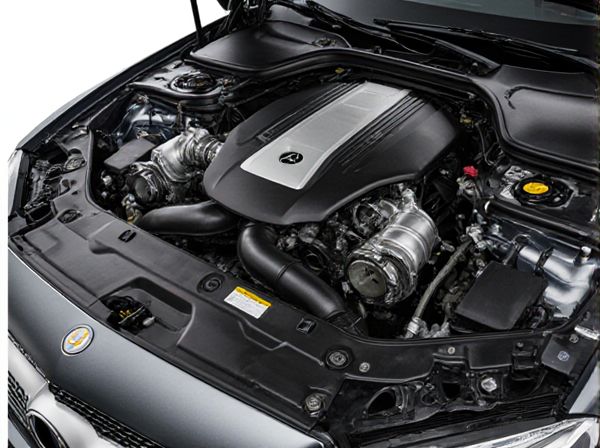
Photo illustration: Sequential Turbocharging vs Twin-Turbocharging
Sequential turbocharging optimizes power delivery by using two differently sized turbochargers that activate at various engine speeds, providing strong low-end torque and high-end power without lag. Twin-turbocharging features two equally sized turbochargers operating simultaneously, often improving overall efficiency and power output with balanced boost pressure. Your choice depends on whether you prioritize smoother acceleration across RPM ranges (sequential) or consistent, high-output performance (twin).
Table of Comparison
| Feature | Sequential Turbocharging | Twin-Turbocharging |
|---|---|---|
| Turbo Setup | Two turbos operate at different RPM ranges sequentially | Two turbos operate simultaneously, either equally or with different sizes |
| Performance | Improves low-end torque and high-end power by switching turbos | Balances power delivery with better response and increased overall boost |
| Complexity | High due to valves and control systems managing turbo transitions | Moderate; simpler plumbing and controls compared to sequential |
| Turbo Lag | Reduced lag by using a small turbo at low RPMs | Reduced lag by simultaneous use of two smaller turbos |
| Cost | Higher due to complex control mechanisms | Lower relative to sequential turbocharging |
| Typical Application | Performance cars requiring wide torque curves | Sports cars and high-performance engines focusing on balanced boost |
Introduction to Forced Induction Systems
Forced induction systems enhance engine performance by increasing air intake pressure, allowing more oxygen for combustion. Sequential turbocharging uses two turbochargers of different sizes activated at separate engine speeds to optimize power and efficiency. Twin-turbocharging employs two identical turbos working simultaneously to reduce turbo lag and improve overall engine response.
What Is Sequential Turbocharging?
Sequential turbocharging utilizes two differently sized turbochargers that operate at varying engine speeds to optimize performance and reduce turbo lag. A smaller turbocharger provides quick boost response at low RPM, while a larger turbo engages at higher RPM for maximum power output. This system enhances engine efficiency and smooth power delivery by seamlessly transitioning between turbos based on driving conditions.
What Is Twin-Turbocharging?
Twin-turbocharging involves using two turbochargers of equal size to simultaneously compress air, improving engine power and efficiency by reducing turbo lag and increasing boost pressure at higher RPMs. Each turbocharger typically feeds one set of cylinders in a V-type engine or works in parallel in an inline configuration, ensuring balanced airflow and enhanced performance across the rev range. This system contrasts with sequential turbocharging, where smaller and larger turbos operate at different engine speeds to optimize power delivery and responsiveness.
Key Differences Between Sequential and Twin-Turbo Setups
Sequential turbocharging uses two differently sized turbochargers that operate at varying engine speeds to optimize power and reduce turbo lag, while twin-turbocharging employs two identical turbochargers working simultaneously to deliver balanced boost across the RPM range. Sequential setups enhance low-end torque by activating a smaller turbo at lower RPMs and switch to a larger turbo for high-end power, whereas twin-turbos provide consistent boost, improving responsiveness and peak performance. The complexity and cost of sequential systems are higher due to intricate valve control mechanisms, contrasting with the simpler design and easier maintenance of twin-turbo configurations.
Performance Benefits of Sequential Turbocharging
Sequential turbocharging delivers enhanced low-end torque and reduces turbo lag by using a smaller turbocharger at lower engine speeds and a larger one at higher speeds, optimizing power delivery across the RPM range. This system improves throttle response and fuel efficiency compared to twin-turbocharging, which relies on two similarly sized turbochargers operating simultaneously. Sequential setups provide smoother acceleration and better overall drivability, especially in varied driving conditions.
Performance Advantages of Twin-Turbocharging
Twin-turbocharging delivers superior performance by utilizing two equally sized turbochargers working simultaneously, providing consistent boost pressure across a wider RPM range. This configuration reduces turbo lag and enhances throttle response, resulting in improved engine efficiency and higher power output. Compared to sequential turbocharging, twin-turbo systems offer better peak performance and smoother acceleration in high-performance vehicles.
Typical Applications: Sequential vs Twin-Turbo
Sequential turbocharging is commonly used in passenger cars and light trucks to improve low-end torque and reduce turbo lag by employing a small turbo at low RPMs and a larger turbo at higher RPMs. Twin-turbocharging, often seen in high-performance sports cars and heavy-duty engines, uses two equally sized turbos operating in parallel to provide balanced power delivery and increased peak power. Sequential setups excel in everyday driving scenarios, while twin-turbo systems are preferred for consistent high power output and racing applications.
Reliability and Maintenance Considerations
Sequential turbocharging offers improved reliability by reducing turbo lag and distributing thermal stress more evenly across smaller turbos, which can lower maintenance frequency compared to twin-turbo systems. Twin-turbo setups, while delivering consistent boost pressure, often require more complex maintenance due to dual independent turbo units, leading to increased wear and potential synchronization issues. Proper maintenance for both systems includes regular inspection of turbo housings, oil lines, and intercoolers to ensure longevity and optimal performance.
Cost Implications and Complexity
Sequential turbocharging involves two differently sized turbos activated at varying engine speeds, increasing system complexity and leading to higher manufacturing and maintenance costs compared to twin-turbocharging, which uses two identical turbos operating simultaneously. The intricate control systems and additional components in sequential setups result in elevated repair expenses and potential reliability issues. In contrast, twin-turbocharging offers a more cost-effective and simpler solution for enhancing engine performance with fewer mechanical challenges.
Choosing the Right Turbocharging System for Your Needs
Sequential turbocharging provides improved low-end torque and smooth power delivery by using multiple turbochargers that operate at different engine speeds, ideal for daily driving and varied conditions. Twin-turbocharging employs two equally sized turbochargers working simultaneously for higher peak power and faster spool-up, best suited for high-performance applications requiring maximum output. Selecting the right system depends on the balance between power needs and driving conditions, with sequential setups favoring versatility and twin-turbo setups emphasizing peak performance.
 caratoz.com
caratoz.com